Korean vegetables that you can easily grow in your home garden – whether it’s in the ground or in pots. These are plants that I have grown for many years so they are pretty easy to grow and you will be amazed by how wonderful they taste when freshly picked!! Don’t wait any longer and start your garden this spring! 🌱
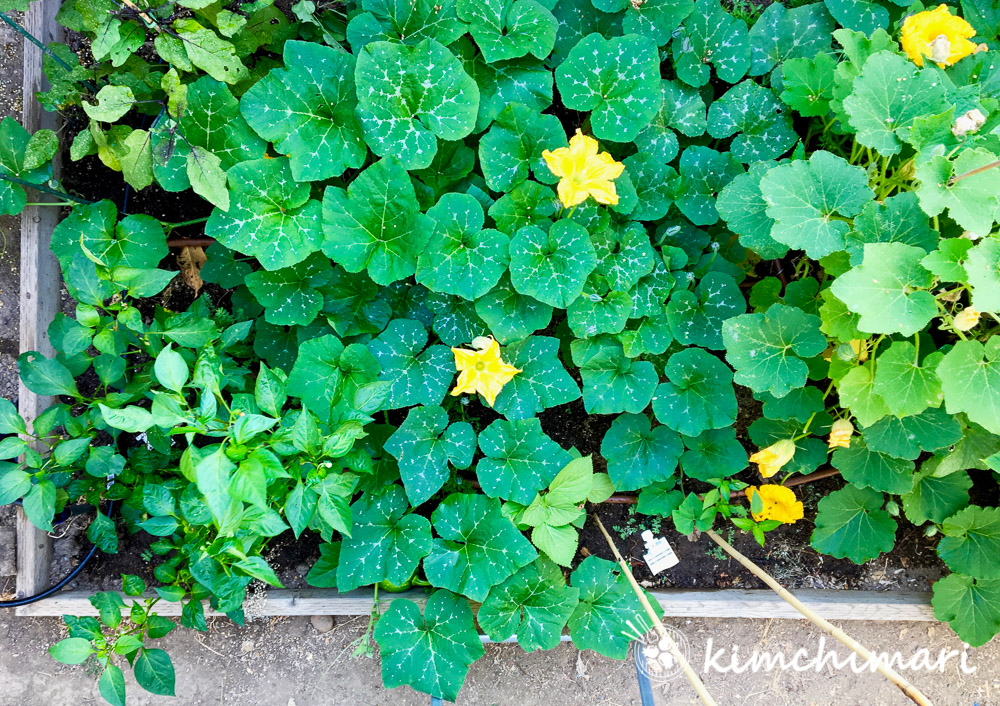
Korean vegetable garden is something I have been doing for over 10+ years now and I can’t imagine living without it. Not only do I enjoy how wonderful they all taste and how fresh they are, I just love watching them grow and picking them whenever I need it.
Table of Contents
Reasons for growing your own vegetables
Gardening is great for Mental Health
For me, my day always starts with visiting my garden of flowers and vegetables. Whenever I smell my roses or see plants grow – I feel my stresses all just melt away and make me think about what heaven must be like. ❤️😇And having my own garden has especially helped me to stay positive and not stress about stocking up vegetables during this difficult time of sheltering in place. This article on Psychology Today talks about the benefits of Gardening on Mental Heath.
Growing your own Korean vegetables is healthy, yummy and reduces food waste
I wanted organic Korean vegetables and it’s hard to find them at my local Korean grocery store. So I decided I would grow them myself as much as possible. Once I started growing and eating my own homegrown vegetables, I realized how amazing everything tasted when they were freshly picked.
Another reason why I grow my own vegetables 😊🥒🌶 is that I hate wasting food – I hate throwing away produce because it went bad before I could cook with them. But a lot of times, Korean markets sell produce in bulk and I have no choice but to buy a lot.
Especially, in this new era where we can’t go to the grocery store very often, we have to stock up but it’s hard to do that with vegetables. But when you grow your own vegetables, not can you just mostly pick it when you need it, it will also stay fresh so much longer in your fridge than the vegetables you buy from the store.
In general, I feel store-bought vegetables will last for a week at most while vegetables that you grow in your garden will last for 2 weeks or more in your refrigerator once picked. It’s because vegetables that you get at the stores will spend many days in storage, in trucks and then again in storage at your grocery store before you buy them and bring it home.
One biggest thing for me are Perilla leaves, I LOVE them but I can’t eat them every day because my husband is not a huge fan. So.. either I buy them and they go bad before I use it all or I don’t buy them and then I don’t have it when I need it. The same goes for Ssukat (Chrysanthemum leaves), Chili peppers and more..
And for me, it’s because I just LOVE to farm
Although my father was a career diplomat, his dream was always to retire from his public service and live on a farm. Sadly, he passed away suddenly before that happened for him but he already had a farm and was working and preparing for years, going back as far as I can remember. If you want to know more, I shared more about my dad’s farm in Korea – HERE.
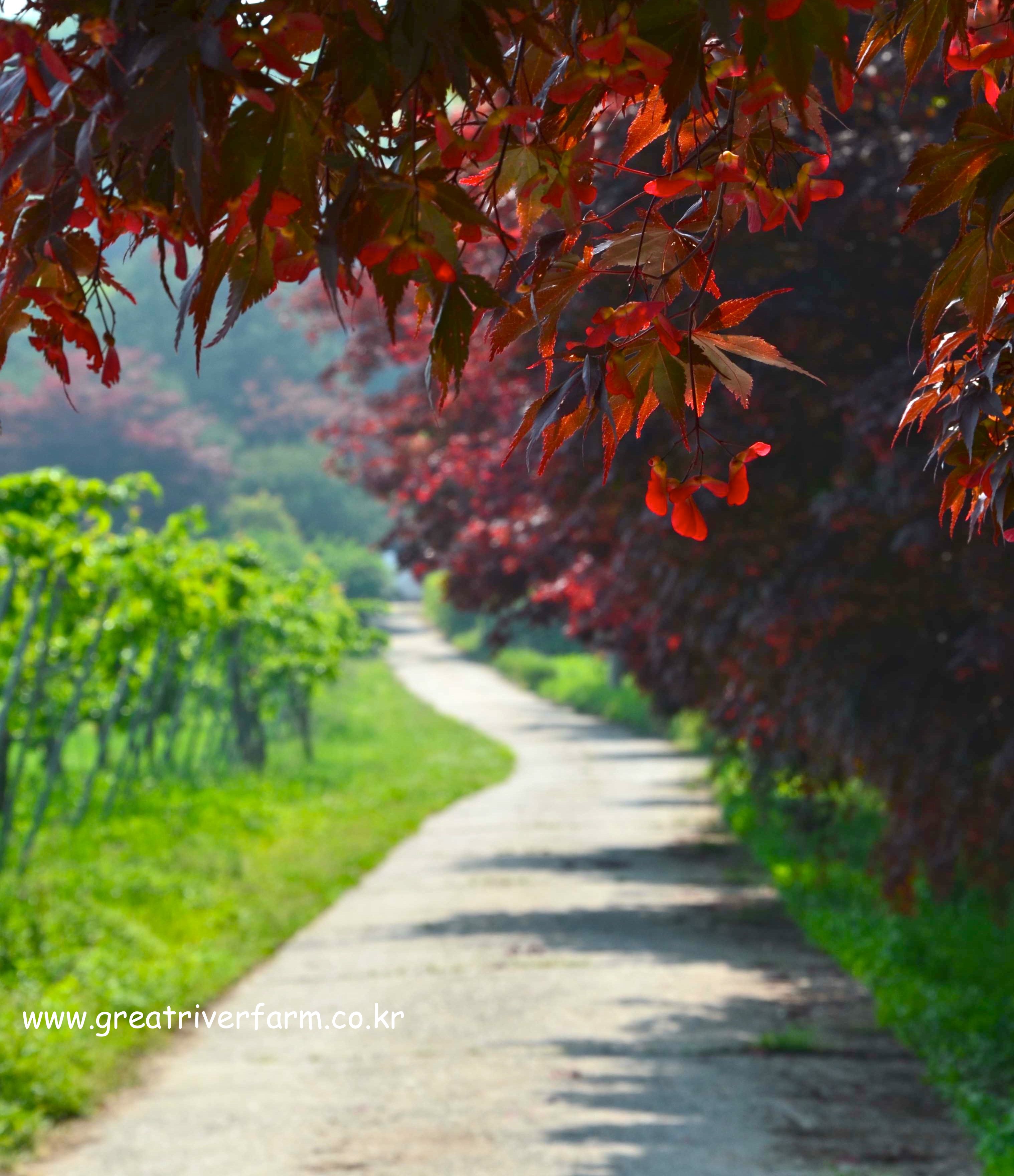
I guess I inherited his love for farming and for animals 🍎🐖because I remember (as a kid) following him around everywhere – from walking around our apple orchard to visiting the very stinky but cute special black piglets imported from New Zealand (I think)… My mom mostly waited in the car but I followed him everywhere he went – through mud and all.💕
MY Korean VEGETABLE GARDEN TOUR
4 Must Korean vegetables to grow in Spring (containers ok)
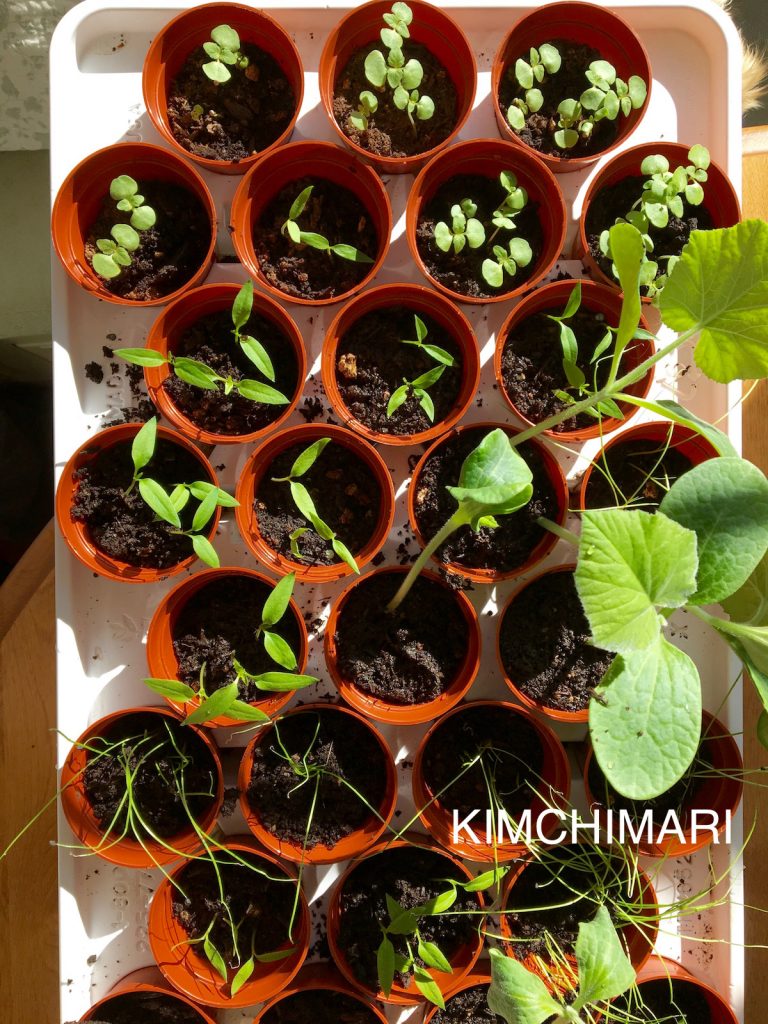
Among many, here are the first 4 must-plant Korean vegetables, even if you don’t have a backyard – because these all do well in large enough pots and you can start them early spring – as soon as the soil temperature goes above 50℉.
1. Green Onions (Pa 파)
Green onions (pa 파) is such an integral part of Korean cooking that it’s hard to do without this beautiful aromatic vegetable. Green onions used in Korean cuisine can be divided into largely 3 types: Daepa 대파, Jjokpa 쪽파 and Silpa 실파.
Korean Recipes with lots of Pa – Green Onion Salad, Green Onion Pancake
Daepa 대파 (Allium fistulosum)
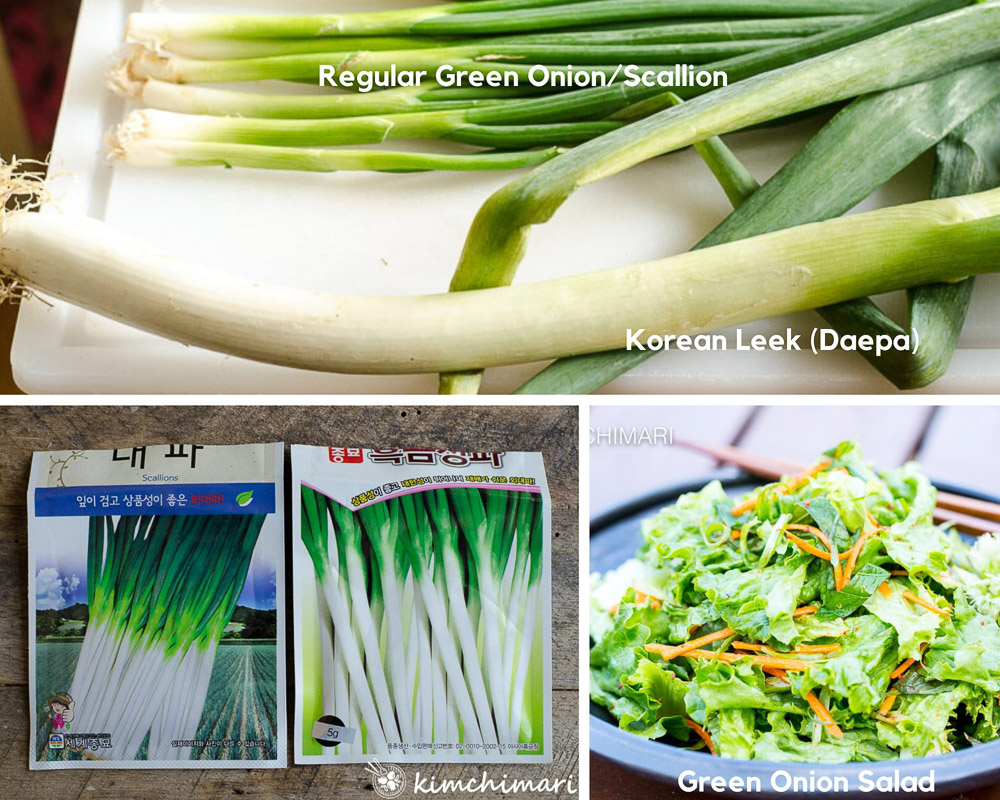
Sometimes called Korean Leek, these are large Korean Green Onions. Fully grown, they are tougher and stronger in taste than regular green onions but still more tender than a standard Leek. These are perfect for soups like Galbitang, Seolleontang and kimchi.
| Korean Seed Varieties (seen in US) | 흑금장파 Heukgeum Jangpa, 금장외대파 Geumjang WaeDaepa (means single stalk) |
|---|---|
| US Seed Varieties | Tokyo Long White Bunching Scallion (matures 65 days) |
| Days till Harvest | 120-150 days |
| Ideal Temps (soil) | 60℉ and above, ideally up to 85 ℉ |
| Planting Time | Spring but Heukgeum Jangpa can be planted also in summer and fall (in mild climates) |
| Depth and Spacing | 1/4" depth, 1" apart in a rows with 12" row spacing |
| Germination Time | 10 -15 days |
| Water | Keep soil moist |
| Light | Full Sun |
The bottom picture shows part of my garden where the green onions are growing in rows. The smaller, thinner bunched up ones (on the left edge) are regular bunching green onions I bought from the local nursery for the first time. I’m not sure how they will turn out – I think they need to be thinned out a bit.
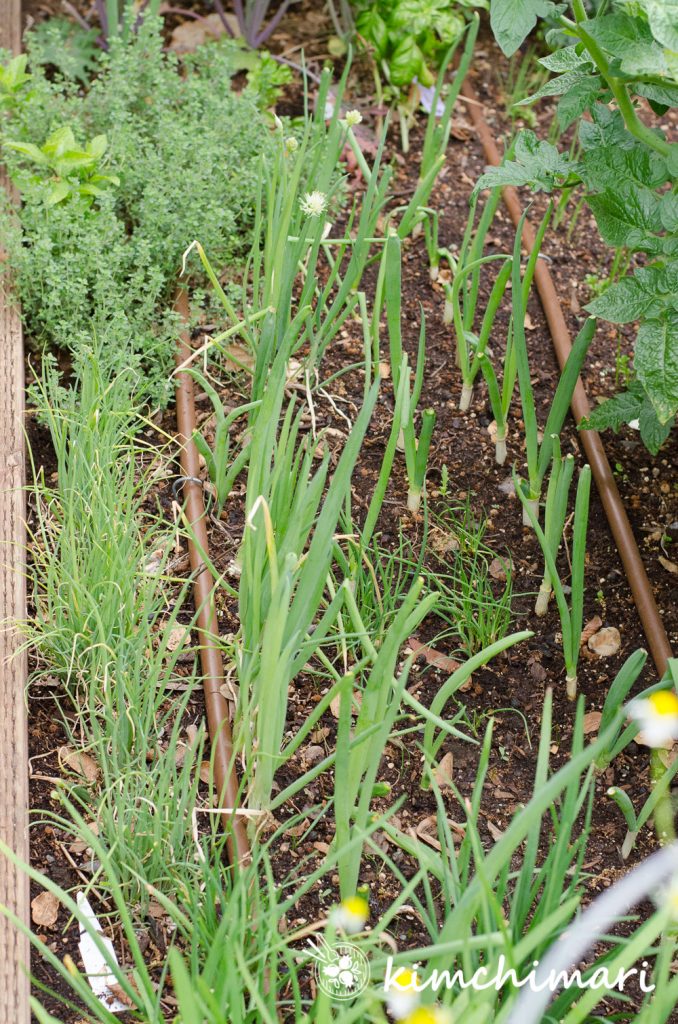
- How to grow: Start seed indoors for a head start (if your climate is too cold) about 8-10 weeks before last frost date and transplant to an outdoor bed or bigger pot. If you live in warmer climates, sow directly outside. The sprouts are really thin and small so don’t overlook it. For longer white stems, mound earth up and over the bottom stem.
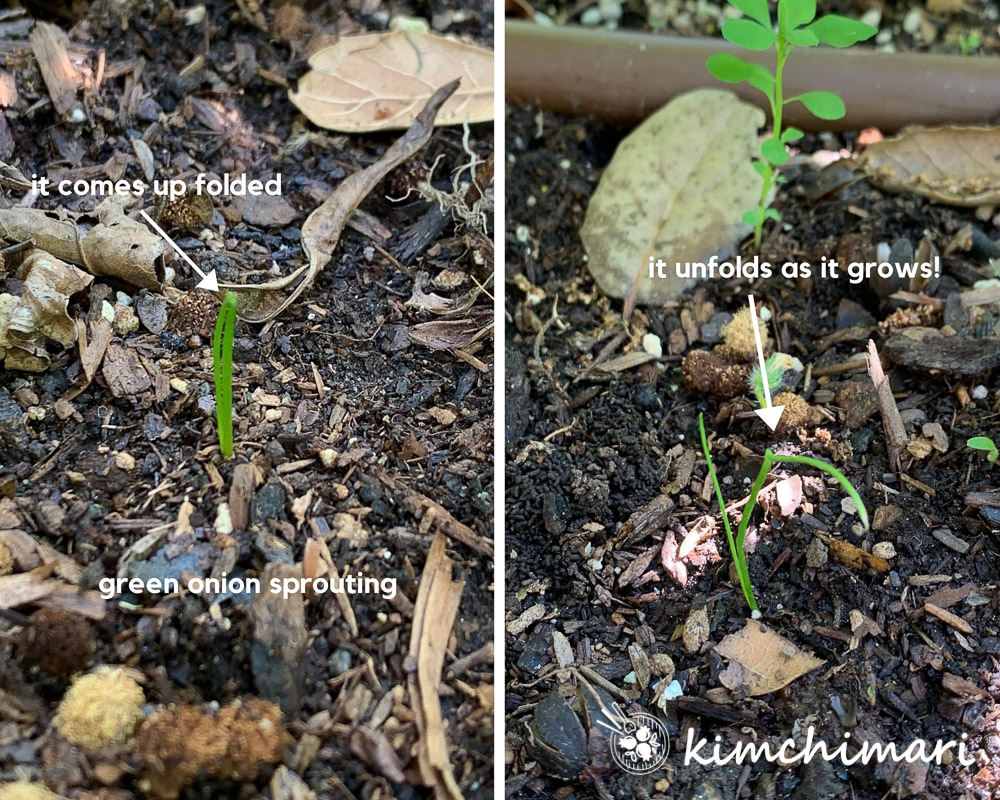
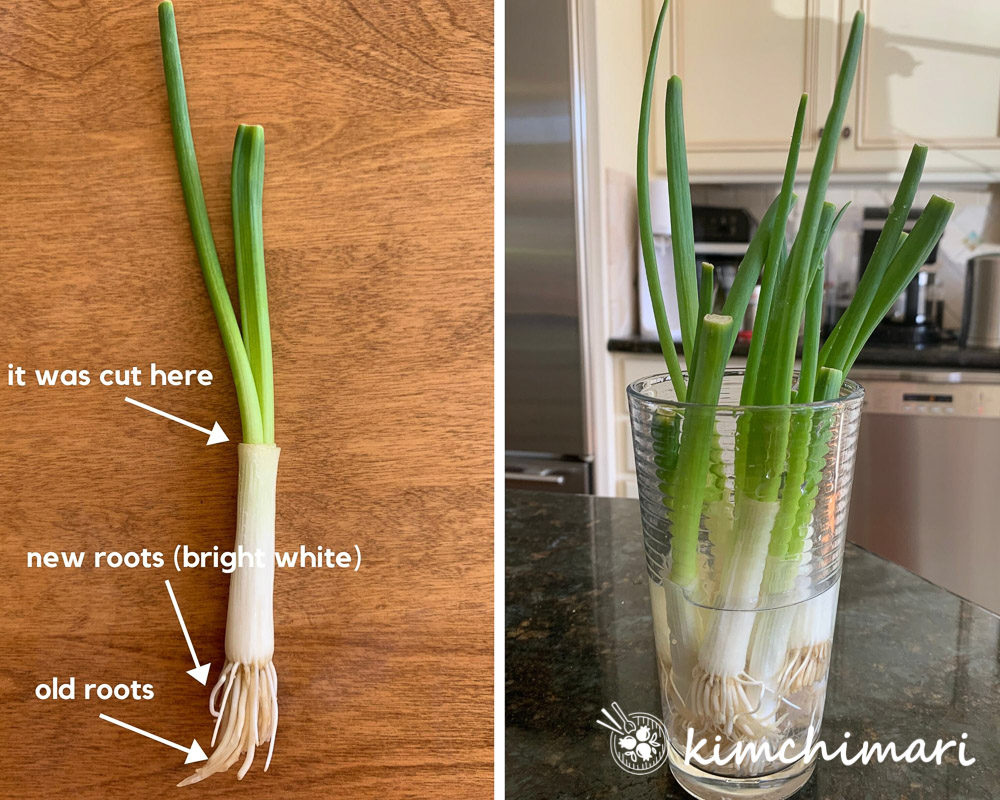
Jjokpa 쪽파 (Allium × proliferum)
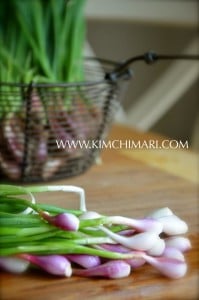
Called Korean bunching onions, somewhat close to purplette onions (but Korean ones are not as deep purple), these are actually a cross between shallots and green onions. They have a great crunch and flavor that Koreans love to add to their Kimchi – especially for Kimjang. As wonderful as it is to have them, I don’t usually have enough room and mostly they can be substituted so I just grow regular Daepa.
2. Perilla Leaves (Kkaennip 깻잎) – Perilla frutescens v. frutescens
Perilla leaves are wonderful Korean herbs that are in the mint family Lamiaceae. They are my favorite for ssam (wrap) and they add great minty and basil like flavor to many dishes. The ground perilla seeds (deulkkae karu 들깨가루) powder and perilla seed oil (deulgireum 들기름) are unique Korean seasonings that give many Korean dishes their special flavor that no other seasoning can substitute.
Some recipes that use the seed oil and seed powder: Gamjatang, Hobak Namul, Perilla Namul, Mushroom Rice
Recipes using Perilla – 10 Ways to cook with Perilla
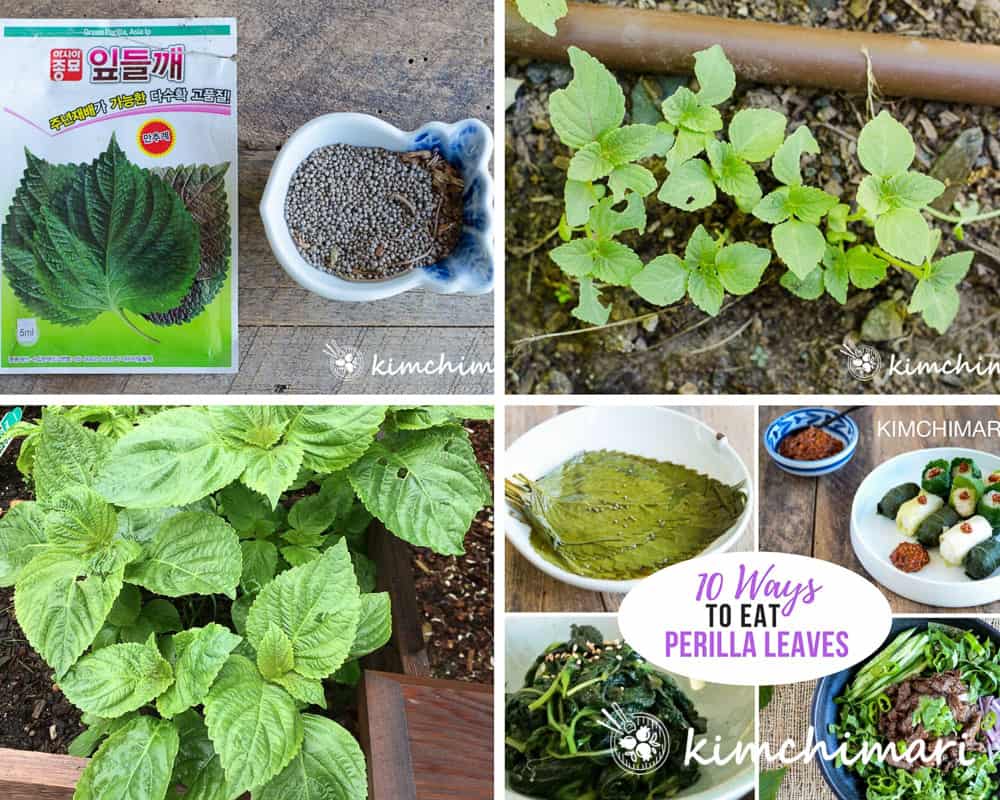
| Korean Seed Varieties (seen in US) | 잎들깨 (Perilla V. Frutescens L. Britt) |
|---|---|
| US Seed Names | Asia Ip, Korean Perilla, Kkaennip. (Not to be confused with Japanese Shiso (Perilla Frustescens v. crispa)) |
| Days till Harvest | 60 -70 days |
| Ideal Temps (soil) | 65-70 ℉ for germination and can tolerate heat well |
| Planting Time | Spring with no fear of frost. Best to seed directly outdoors. |
| Depth and Spacing | Lightly tamp seeds into soil. Plant 12-24" apart with 2' row spacing. |
| Germination Time | 14 days |
| Water | Moderate but gets stressed during long drought |
| Light | Full Sun, Partial Shade |
- Different Korean Seed Varieties (that I have seen in the US): In the Korean markets, you will usually see just one type – Deulkkaennip 들깻잎 (Perilla frustescens var frutescens or Perilla frutescens Britt). Korean Perilla can come in green on top and bottom of the leaf or green on top and slightly purple underneath – and both work fine. Don’t get confused with Japanese Shiso (Perilla Frustescens var crispa) which comes in both green and red leaves and the edges are lot more jagged looking. Shiso also has a very distinct flavor that’s wonderful in Japanese food but just does not work we’ll with Korean food.
- How to grow: Start seedlings indoors 4-6 weeks before last frost if you have cold and long winters but I find direct seeding in early spring when fear of frost has passed works best. They work well in containers too so you could also plant in big pots to begin with and take them outside when it gets warmer. They need light to germinate. Once they seed, they will self-seed and propagate like weeds the following year. You can also cut the plant once the seeds set in, dry them and shake off the seeds to collect your own Ddeulkkae (perilla seeds).
- How to harvest: harvest individual leaves from the bottom up, or break off the top to promote branching into more stems.
3. Chives (Buchu 부추) – Allium tuberosum
Chives is probably the easiest plant to grow among all of the vegetables listed here because it’s perennial and self-propagating. BTW, Korean Chives used in Korean cooking is different from the chives you see at regular grocery stores. These yummy chives have thick flat leaves like giant grass and have a wonderful garlic flavor – much stronger than the delicate small chives you may be used to but works perfectly in Korean dishes.
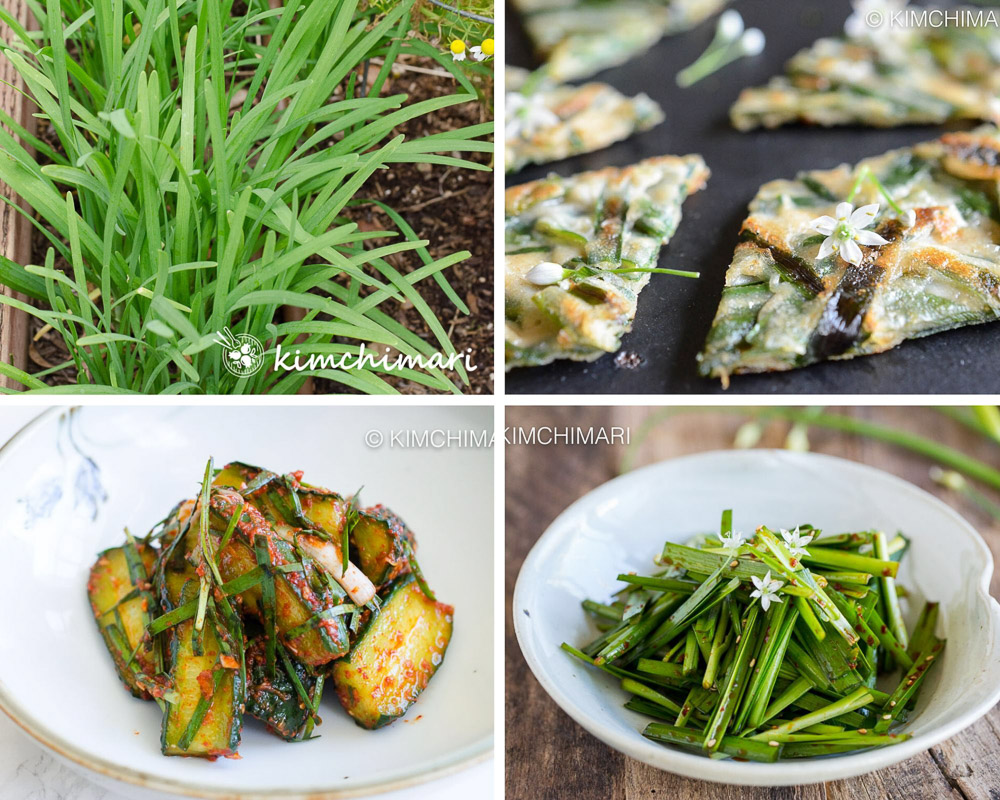
Korean Buchu (chives) are also called garlic chives, Asian chives, Chinese chives and Chinese leek. Korean grocery stores always tend to sell these in HUGE bunches but the sad thing is that they also go bad pretty quickly and it’s a pain to rinse off the mushy spoiled leaves once some have spoiled… 😖 and that’s why I started to grow them at home and I almost never need to buy chives now.
Korean Recipes with Chives: Buchu Jeon(pancakes), Buchu Salad, and Cucumber Kimchi (pics above)
| Korean Seed Varieties (seen in US) | Buchu GreenBelt (부추 그린벨트) |
|---|---|
| US Seed Varieties (Kitazawa seeds) | Flowering Chinese Leek |
| Days till Harvest | 70 days |
| Ideal Temps (soil) | 60-70 ℉ |
| Planting Time | Spring or Summer |
| Depth and Spacing | 1/4-1/2" depth, 1/2" apart in with 14-20" row spacing |
| Germination Time | 2-3 weeks |
| Water | Keep soil moist |
| Light | Full Sun or Part Shade |
How to Grow: Sow seeds in spring/ summer after last frost in sun or part shade. Keep soil moist – if the soil is too dry, it will not grow much. Although there’s a recommendation for plant spacing, I find that they grow fine even when crowded. Harvest by cutting just above ground level.
How to Harvest: Similar to green onions, chives love to grow back when cut. Harvest by cutting above ground level and it will grow back full every time. It is better to cut often than not as they tend to grow tough and slightly woody if left too long. I also love to harvest flowers to add to my dishes. They have a lovely mild chive flavor.
4. Lettuce (Sangchu 상추)
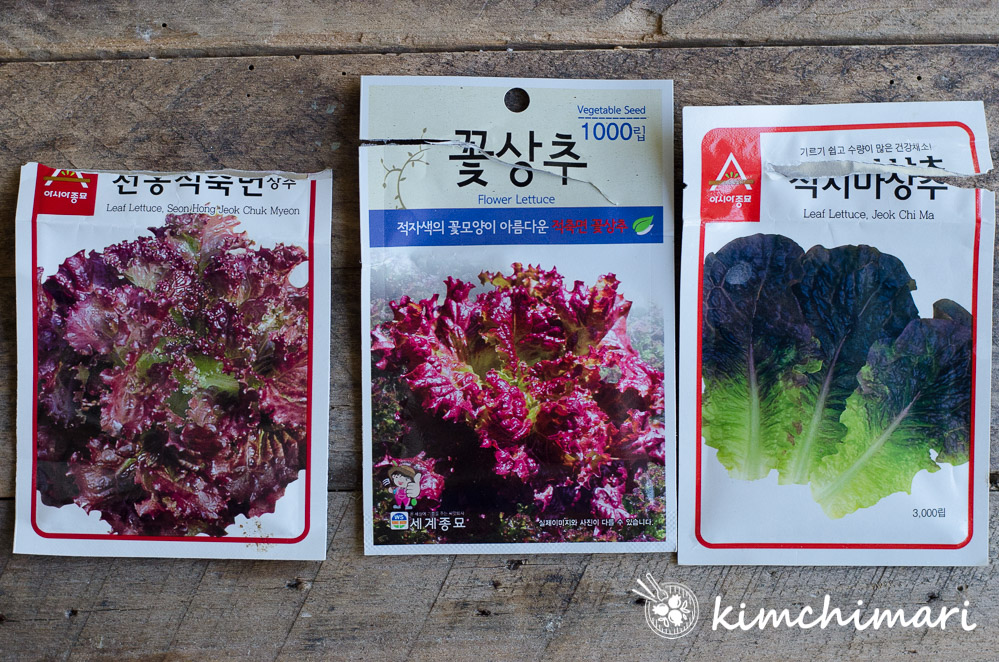
There are too many varieties of lettuces so it’s hard to limit to just a few plants but overall, these are the seeds that I get from my local Korean store – left to right Seong Hong Jeok Chuk Myeon 선홍적축면, Kkot Sangchu 꽃상추, Jeok Chi Ma 적치마 Sangchu 상추.
Recipes that use lettuces – Lettuce Salad, Bolted Lettuce Kimchi.
| Korean Seed Varieties (seen in US) | 꽃상추 Kkot Sangchu (labeled as Flower Lettuce), 적치마상추 Jeokchima Sangchu |
|---|---|
| US Seed Varieties | Ruby Red Lettuce, Red Leaf Lettuce, Green Leaf Lettuce all works |
| Days till Harvest | 45-70 days (depending on condition and variety) |
| Ideal Temps (soil) | 60 -70 ℉ (will bolt and grow flowers if too hot) |
| Planting Time | Spring and Fall (in mild climates) |
| Depth and Spacing | 1/8" deep, cover seed lightly. 2" apart with row spacing at least 6" |
| Germination Time | 7-14 days |
| Water | Keep moist |
| Light | Full Sun to Part Shade |
And you don’t have to plant exactly these. You can plant any common red leaf or green leaf lettuce, even romaine lettuce works as ssam material or in any salads. Read my post on Ssam greens to learn about all the different leafy greens you can make ssam with.
In addition to the fact that lettuces go bad pretty quickly in your fridge, lettuces also are a lot more tender and sweeter when you grow them fresh at home. They grow well in containers and many Koreans grow them in pots (or even in those big styrofoam boxes 😲) in their apartment verandas – so you know they grow well in containers!
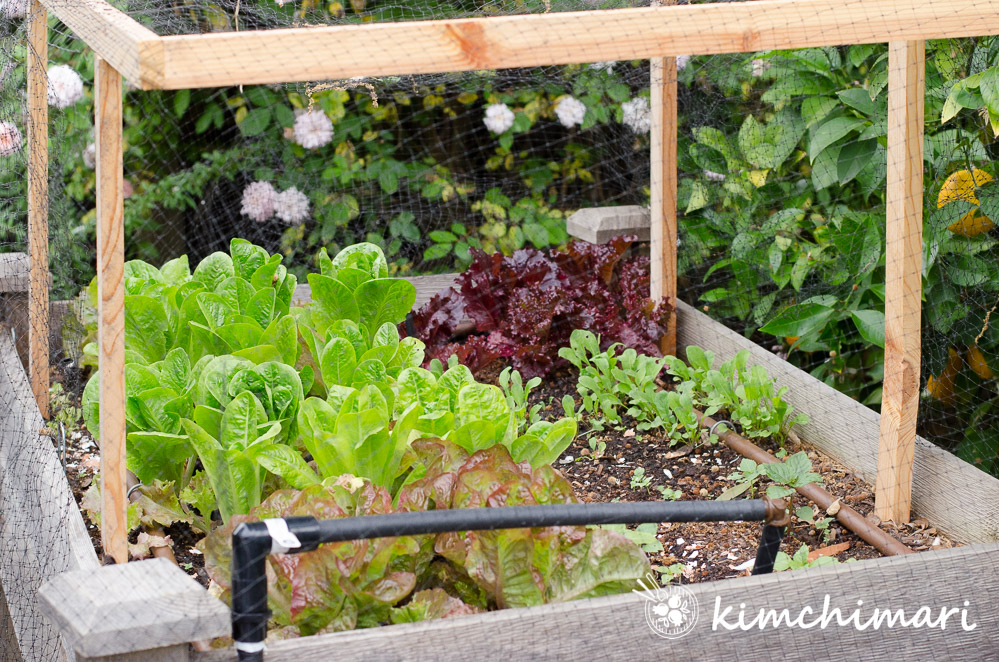
- How to grow: Lettuce likes a lot of water and in California, due to strong sun, I think they do better in part shade. Overall, lettuce do better in cooler temperatures and they will bolt when it gets too warm so don’t plant during hot summers. Once it bolts, it will start to taste bitter and won’t be good to eat raw.
- How to harvest: pick individual leaves from the outer edges of the lettuce (so the smaller inner ones continue to grow) or cut off the lettuce but leave the bottom stem and roots and they will regrow. Once it bolts, you can make Bolted Lettuce Kimchi so try that when it happens next time!
- Shortcut: just like green onions, you can regrow store-bought lettuces by cutting off the leaves above the bottom root end and having it sit in water, waiting until roots form and leaves start to grow. Then plant them in the ground.
6 Korean vegetables to grow in late Spring/early Summer
These are my favorite summer vegetables to have in my garden. I like to grow these because again, either they go bad by the time I use it all or I have to go to the store just to buy one Hobak for Jjigae. BTW, both Squash and Cucumbers probably are best grown in the ground in big pots as they can get quite big.
5. Squash (Hobak 호박)
One of the vegetables I missed the most when I lived in Florida was the Korean squash. Because there was no Korean grocery store nearby that sold fresh Korean vegetables so I had no way of getting them. Korean squash is different from common zucchini – they are more tender, juicier and even slightly sweet.
Koreans love to add Hobak to everything but also love to steam the leaves to make ssam or seasoning them with Doenjang. Here’s my recipe for making Ssambap with steamed Hobak Ip (호박잎).
- Different Hobak Varieties: There are mainly 2 different kinds of Korean Squash (Hobak).
- Aehobak 애호박 (Cucurbita duschesne), which means ‘baby squash’, is longer shaped and has very soft but dense skin. It is used in many Korean dishes like Hobak Jeon, Hobak Buchimgae, Vegetarian dumpling and even dried to make Hobak Namul.
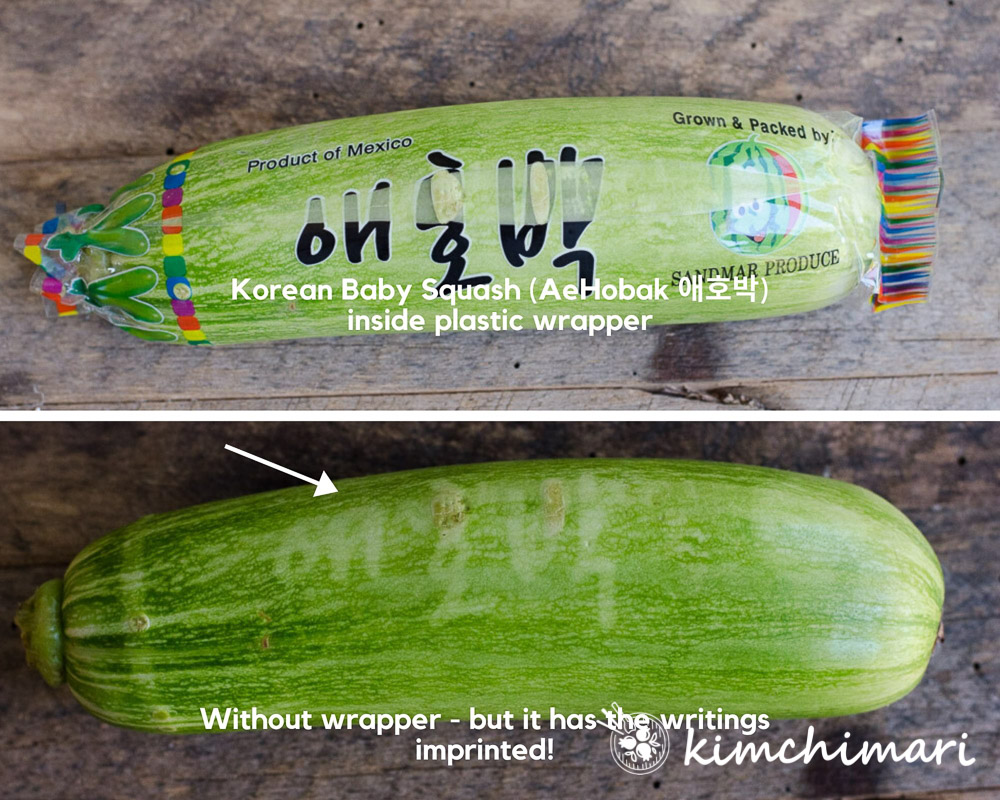
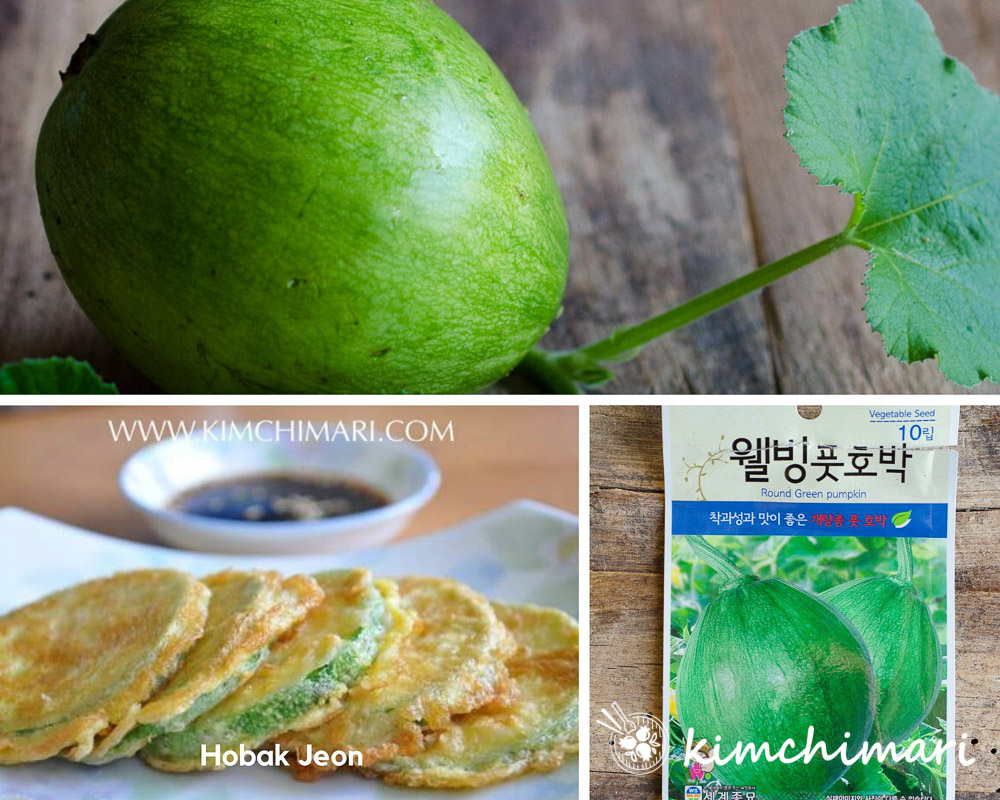
| Korean Seed Varieties (seen in US) | Cucurbita Moschata (웰빙풋호박 wellbeing put hobak , 텃밭풋호박 Teot Bat Put Hobak), Cucurbita Duschesne (으뜸애호박 Eutteum Aehobak, 진동애호박 Jindong Ae Hobak) |
|---|---|
| US Seed Varieties (Kitazawa seeds) | King Ka Ae Hybrid, Early Bulam Hybrid, Teot Bat Put Hybrid |
| Days till Harvest | 65-70 days (put hobak) |
| Ideal Temps (soil) | 70-95 ℉ |
| Planting Time | Spring/Summer after last frost |
| Depth and Spacing | 1" depth, 10-12" apart in with 3-4' row spacing |
| Germination Time | 7-14 days |
| Water | Keep soil moist |
| Light | Full Sun |
- How to grow: Squash prefers warm temperatures. Sow seeds in spring/summer after the last frost in a warm, sunny location. Keep soil moist – and water deeply every now and then. You can let it sprawl on the ground or train to climb a trellis for better air circulation. Squirrels love to take a bite so protect it from those critters!!
- How to harvest: Squash grows really fast once fruit sets so check on it every day and don’t let it grow too big (no bigger than 4 inches wide) because then it’s no longer tender and forms hard seeds.
6. Korean Chili Peppers (Gochu 고추) – Capsicum Annuum
If you love Korean food and spicy then this may be THE Korean vegetable to grow – Gochu 고추. Plant a few chili pepper plants in the ground or in pots in different varieties. Put Gochu should be your first choice to plant as it is the most versatile. If you have more space and want to make Kimchi or Gochujang, you can plant Hong Gochu varieties and make your own Gochugaru!
- Korean Chili Varieties: Koreans love chilis and so there are just too many varieties to choose from but one can divide them largely into Put Gochu 풋고추 (young green peppers) and Hong Gochu 홍고추 (mature red peppers). ** SHU stands for Scoville Heat Unit
- Hong Gochu comes either fresh or dried. They are spicy but also have a slight sweet flavor.
- Recipes that use Hong Gochu: Fresh ones are finely blended to make Kimchi or stews like Maeuntang. Dried red peppers are ground into a powder to make Gochugaru (red chili pepper powder) which is used in Kimchi, Gochujang and more.
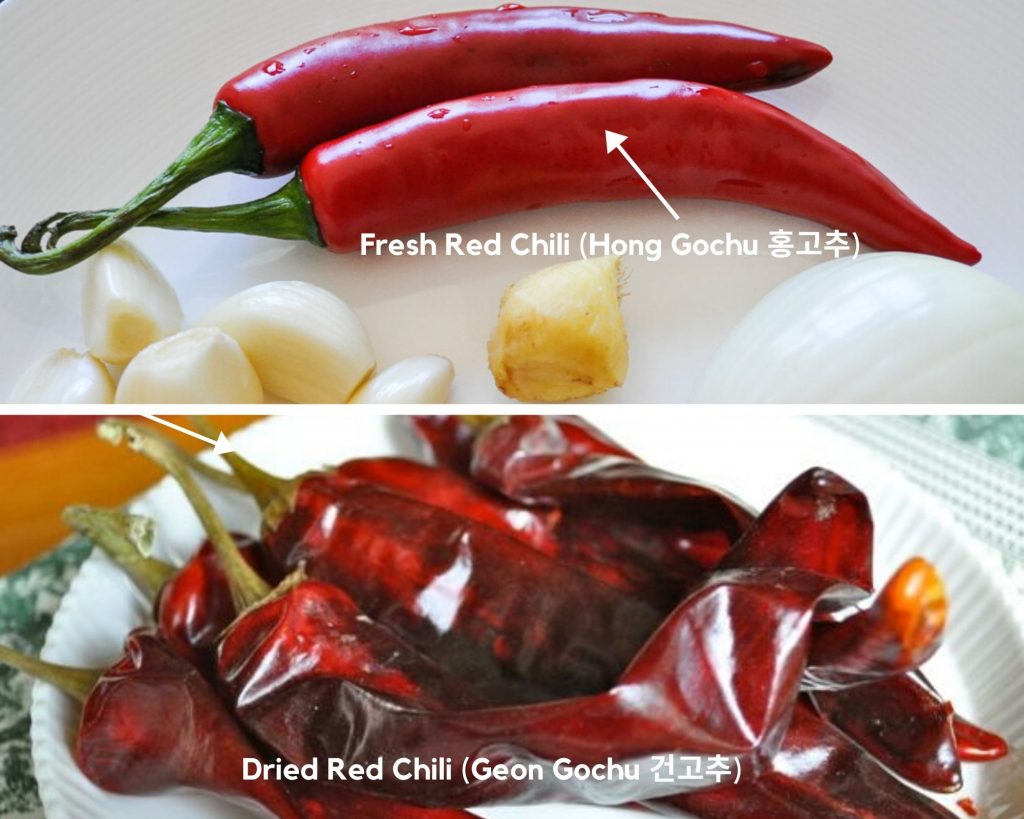
Hong Gochu range from moderate SPICY to very SPICY and they are matured until red and used fresh or dried. In the US, they go by Korean Long Green Peppers/Korean Hot Peppers/Gochujang Hot peppers/Lady Choi among many names.
BTW, Lady Choi is a variety that Kitazawaseed developed in partnership with Namu Gaji restaurant chef Dennis Lee. Lady Choi is said to be delicious in all stages.
- Put Gochu is the most versatile – eaten fresh with ssamjang or added to stews, sauces or pickled. Among Put Gochu (green peppers), you have the very MILD ones like Oi Gochu 오이고추 (Cucumber peppers < 500 SHU), regular Spicy Gochu (around 1500 SHU) and VERY SPICY Cheongyang Gochu 청양고추 (4000 – 7000 SHU, up to 12000).
In the US, Annaheim Peppers (500-2500 SHU) can be a good substitute for Oi Gochu. And Serrano (1000-23,000 SHU) or Jalapeno Peppers (2500 – 8000 SHU) are good substitutes for the regular spicy Put Gochu.
- Recipes with Put Gochu (Green Chilis) – Jangahjji (pickles), Bulgogi Rice Bowl, Sashimi Bowl, Doenjang Jjigae
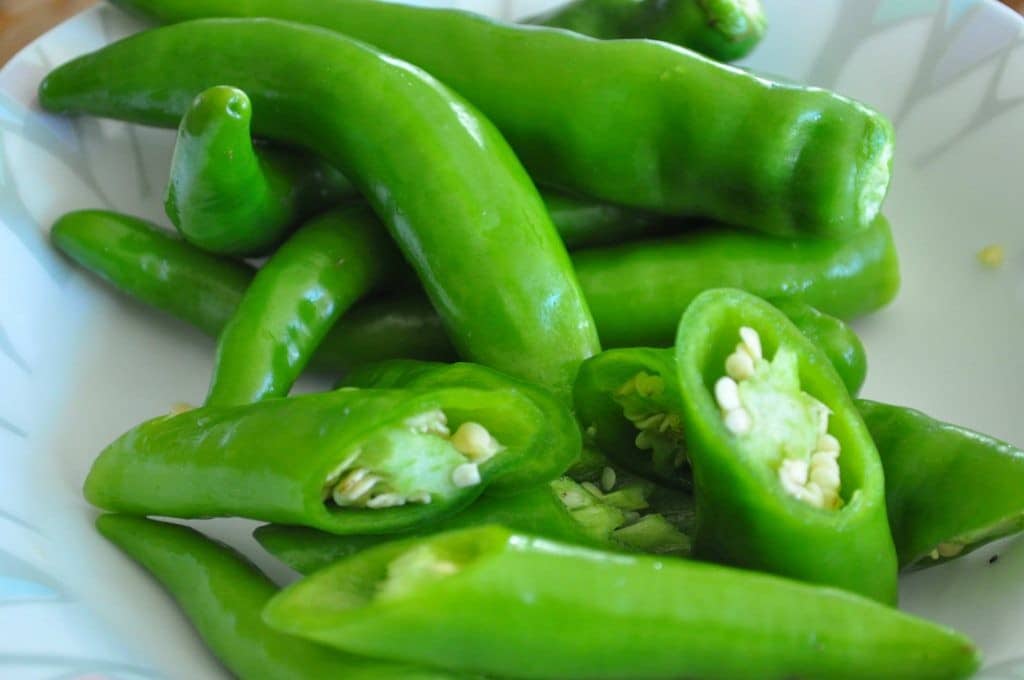
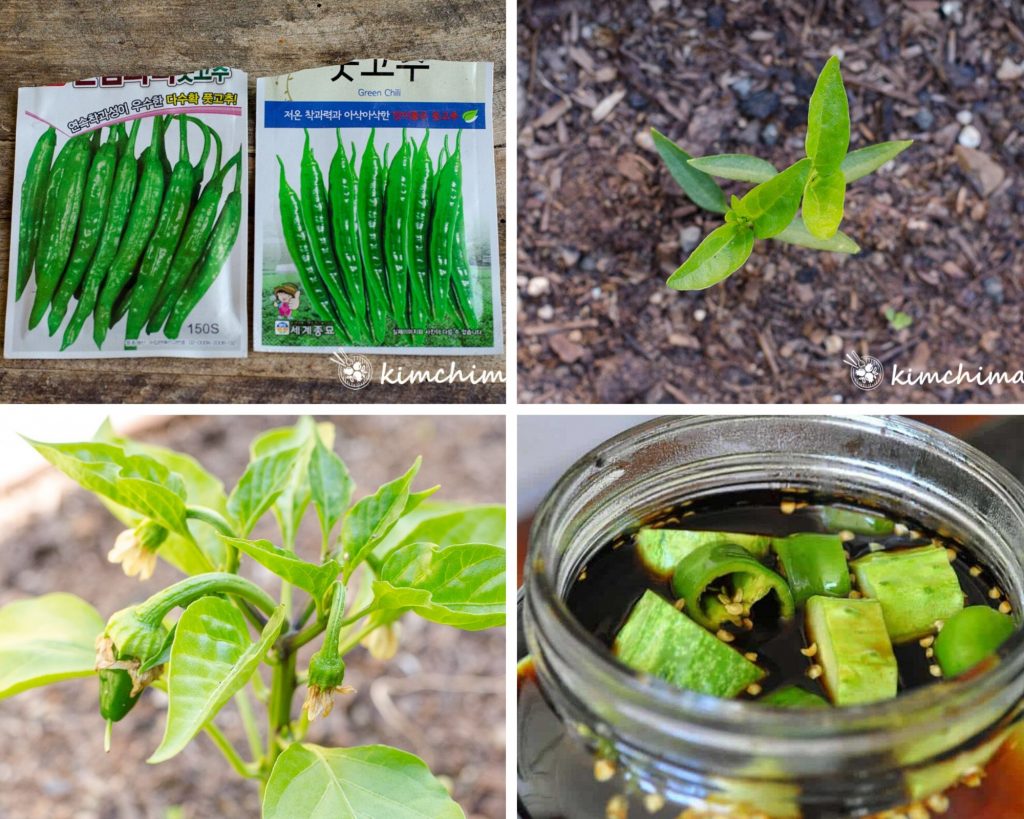
Don’t forget there’s Kwari Gochu 꽈리고추 (Shishito peppers)!! My favorite!! ❤️
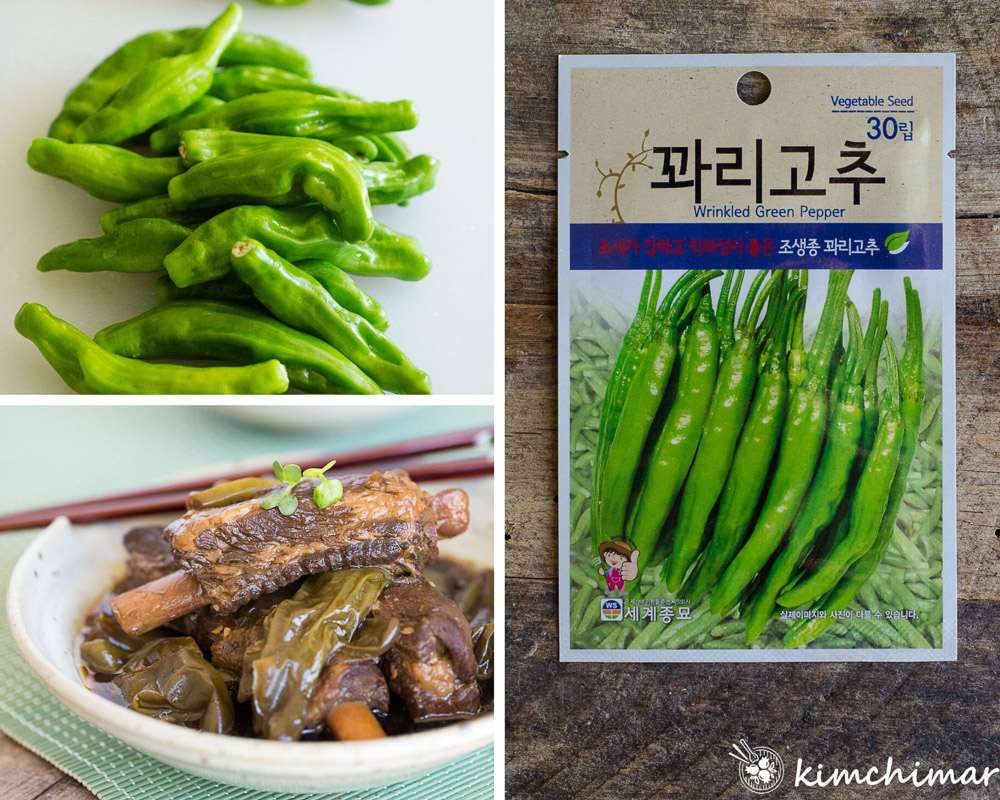
I love cooking with these – I add them to Jangjorim, Myeolchi Bokkeum and Pork Ribs Jorim. I always plant about a few every year. You can probably buy these from any store or seed company. Follow directions on the packet to grow them but are similar to chili peppers above. Note, how Korean seed company calls it ‘wrinkled green peppers’.. 😂🤣rightfully so..
| Korean Seed Varieties (seen in US) | 과일풋고추 Gwail putgochu (Green Chli) |
|---|---|
| US Seed Varieties | Korean Cucumber Pepper (not spicy), Lady Choi (can also use to make gochukaru) |
| Days till Harvest | 70-100 days |
| Ideal Temps (soil) | 80-90 ℉ for germination and warm summer is best |
| Planting Time | Spring or start seeds indoors 6 weeks before last frost date and transplant in late spring/summer |
| Depth and Spacing | 1/4 - 1/2" depth, 12 - 14" plant spacing, 24" row spacing |
| Germination Time | 1-3 weeks (need warm soil) |
| Water | needs deep watering once established but doesn't like a lot of moisture |
| Light | Full Sun |
- How to grow: Start seeds inside 6 -8 weeks before last frost date if you want to get a head start and you live in a cold climate. Seeds will not germinate in cool soil and planting out too early may affect growth. Chilis love warm weather so transplant in late spring/summer (soil temperatures at least above 60°F) in a very warm and sunny location. Plants must dry out completely before watering – it doesn’t like humidity, don’t water too often and water deeply when you do.
- Shortcut: Buy Jalapeno and Annaheim pepper plants from your local nursery. With about 4-5 plants, I usually have enough to make my husband’s favorite Jangahjii with them.It’s fabulous with BBQ meats but just yummy anytime. This particular Jangahjji recipe keeps at room temp for months so I make a batch in the summer and enjoy it all year long!
7. Cucumbers (Oi 오이)
There’s nothing better than having fresh cucumbers directly from the garden to make cucumber kimchi and salads or making pickles (see pic above) with it. I grow my own Korean cucumbers because they make a big difference in texture and flavor in Korean cooking.
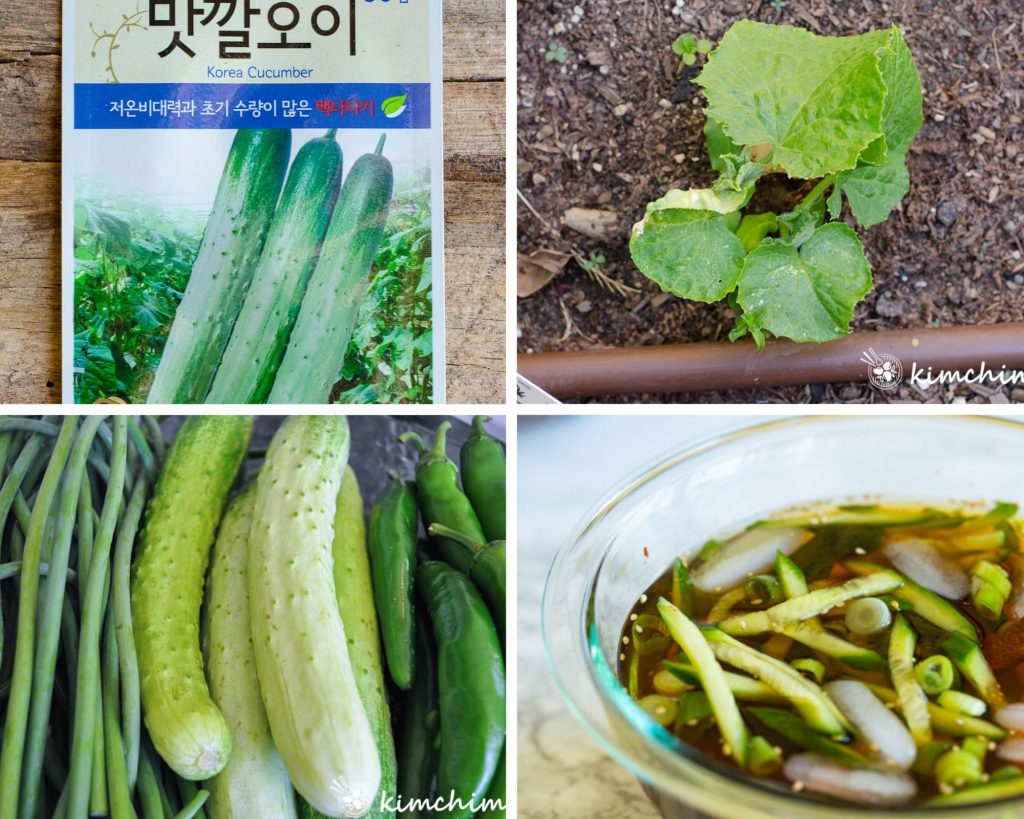
- Korean Cucumber Varieties: Korean Baekdadagi 백다다기 (pic above) is a very crunchy cucumber with lots of juice and tender skin and this is the most popular variety sold at markets in Korea. It’s great for pickling, kimchi and for eating fresh. There’s also Gashi Oi 가시오이 which is dark green, thinner and quite prickly. Best used fresh only so because of that it’s not very popular. Lastly Cheong Oi 청오이 which is also dark green and grows well in the warmer, southern region of Korea but the flesh gets easily soft so it’s not good for kimchi or pickling.
The seeds sold in the US are mostly just the Baekdadagi kind. You can also grow pickling cucumbers or Japanese cucumbers if you can’t find Korean cucumber seeds.
| Korean Seed Varieties (seen in US) | Cucumis Sativus (Asia EunCheon Oi 아시아은천 오이, Matgal Oi 맛깔오이) |
|---|---|
| US Seed Varieties (Kitazawa seeds) | Asia EunCheon Hybrid, Joseon Shorty |
| Days till Harvest | 55-60 days |
| Ideal Temps (soil) | 75 - 85 ℉ |
| Planting Time | Late spring to early summer |
| Depth and Spacing | 1" depth, 10-12" apart in with 2-3' row spacing |
| Germination Time | 7-10 days |
| Water | Keep soil moist |
| Light | Full Sun |
- How to grow: Sow seeds in late spring/early summer after the last frost in a warm, sunny location. Or start seeds indoors and transplant when the weather warms. Keep soil moist. Best growing temperatures 65 – 75°F but can be warmer. Cucumber fruits will curl up if there’s no room to grow so it’s best to train the plant to climb a vertical trellis or ladder for better air circulation and straighter looking fruits. Also easier to harvest. Be sure to harvest cucumbers at the right time, if you let it grow too old, it will start to become tough, yellow and even bitter. Koreans make Nogak Namul with old cucumbers.
8. Chrysanthemum Leaves/Crown Daisies (Ssukat 쑥갓)
I failed to grow these beauties last year because I planted it too late in spring and it got too hot and dry too fast. But it self-seeded last fall and it went crazy this spring!! 😍 These are already flowering now, I think they were at their peak in March and early April. So technically I didn’t plant it – it just grew on its own (see pic)!
It probably should have been thinned out but I just didn’t get to it this spring. This is a beautiful herb that you can add to fish stews, ssam, Bulgogi Rice Bowls, Bibim Guksu, make namul with or tofu salad (pic above)…😍 I love this as much as Perilla and it really adds a wonderful fragrance and brightness to a dish.
| Korean Seed Varieties (seen in US) | 쑥갓 (Glebionis coronaria) |
|---|---|
| US Seed Names | garland chrysanthemum, chrysanthemum greens, edible chrysanthemum, crown daisy, chop suey greens |
| Days till Harvest | 40 - 50 days |
| Ideal Temps (soil) | 60℉ for germination but shouldn't be over 85℉. Grows best in cooler but not too cold temps. |
| Planting Time | Spring with no fear of frost. Can be sown directly outdoors or transplanted. |
| Depth and Spacing | Plant about 1/4" deep with about 4 inch spacing in between. |
| Germination Time | 7-10 days |
| Water | Moderate, keep soil moist |
| Light | Full Sun, Partial Shade |
How to grow – Sow in spring or late summer/early fall. It will be fine with light shade in summer. It’s pretty easy to grow but needs good moisture and cooler temperatures. Similar to Perilla, you can harvest the top young stems and it will grow into more branches! Seed depth 1/4-1/2″, 1-2″ spacing, 14-20″ row spacing.
How to harvest – ssukat is very tender when young and the whole plant can be eaten but as it grows bigger, the main stem becomes a little too tough so it’s best to pinch the tender tops. Also, by pinching the top, the plant will shoot up 2 stems and you will have more to harvest.
9. Korean Cabbages (Baechu 배추)
Of course, when you see Cabbages, you are probably thinking about the big huge napa style cabbages that you make kimchi with. But these cabbages need a lot of space, effort, time and a bit of skill to grow. And these days, you can buy napa cabbages pretty easily from stores.
I think the following two are great Korean cabbages to grow in your garden that you can use in your daily Korean cooking and also make kimchi with. But if you have a lot of land and would still like to grow your own napa style cabbage for Kimchi.
- Bomdong 봄동 – these cabbages don’t wrap tightly as they grow but spread out like a flower as you see below. Read more in my Bomdong Geotjeori recipe. These taste great fresh so it’s great for making fresh quick kimchi, salads or eating ssam with the inner leaves. I have been seeing seeds sold here recently so you should be able to buy them.
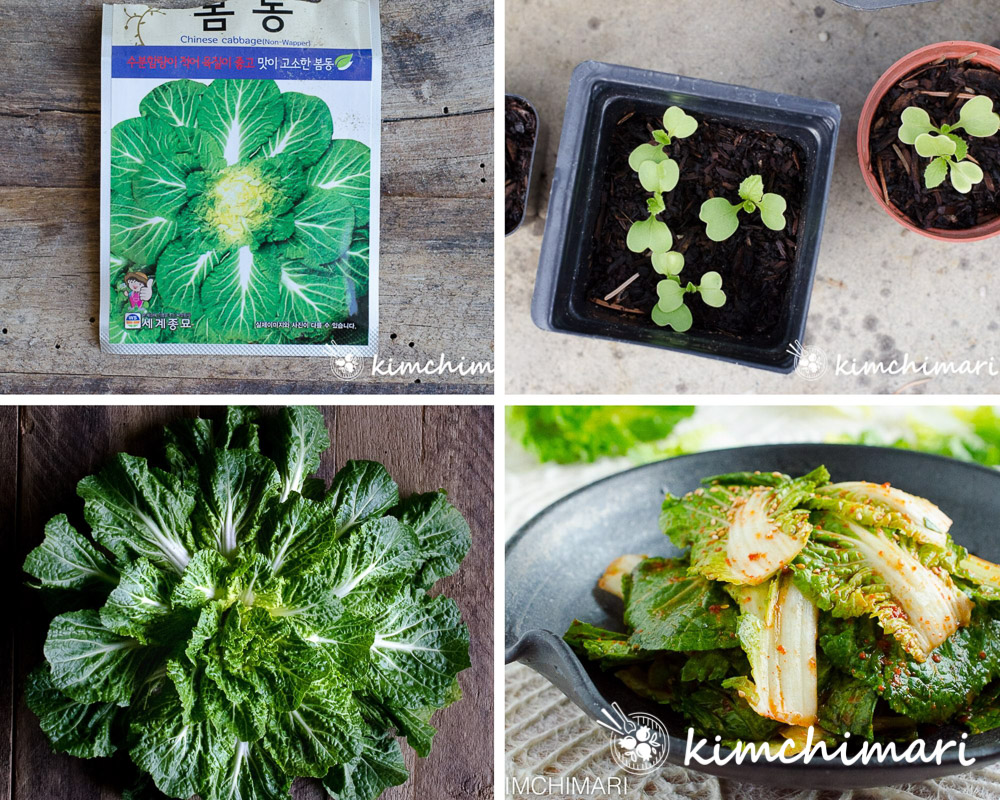
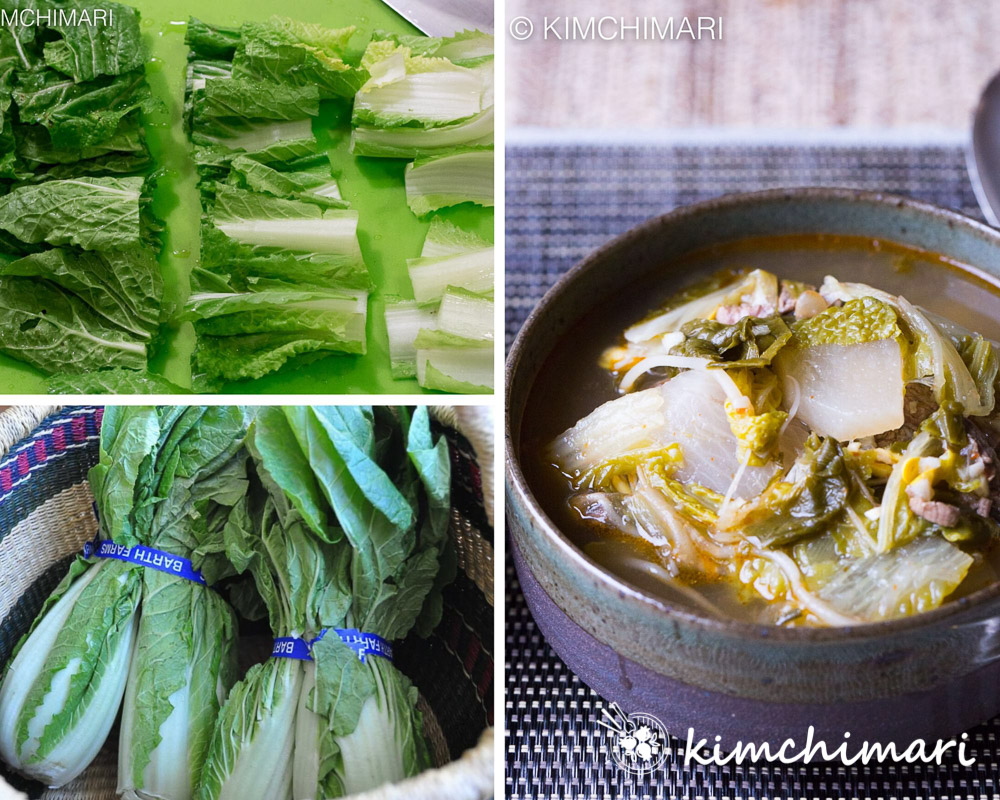
Well, whew..that’s all for now. I hope this was helpful. Please let me know if you found it useful and don’t forget to join my Facebook group or follow me on IG so you can ask questions and share your progress!!
Stay safe and be well my friends,
XOXO ❤️
JinJoo
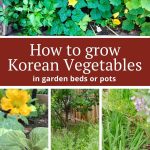
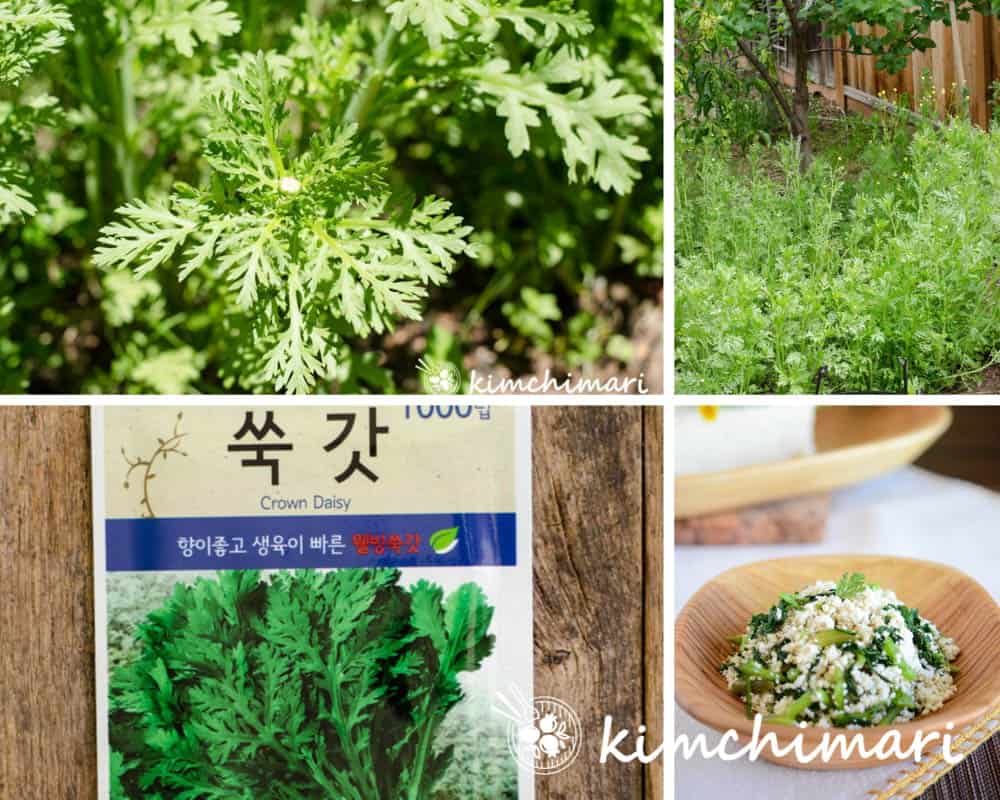
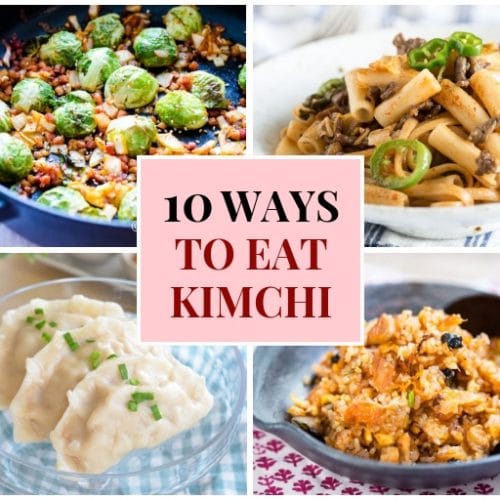
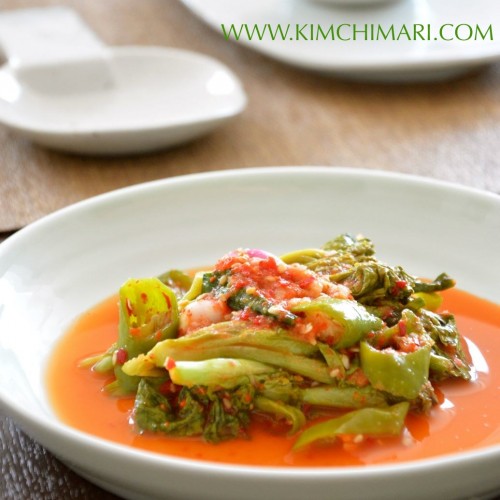
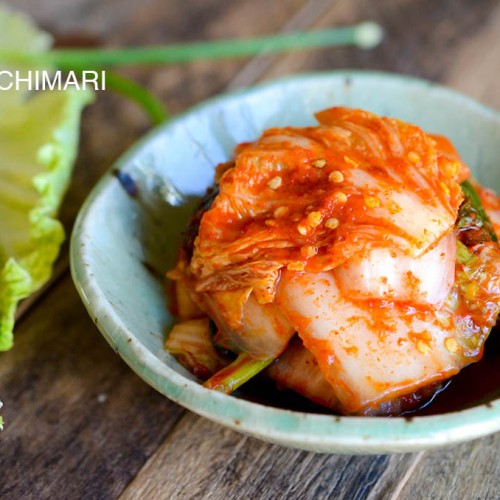
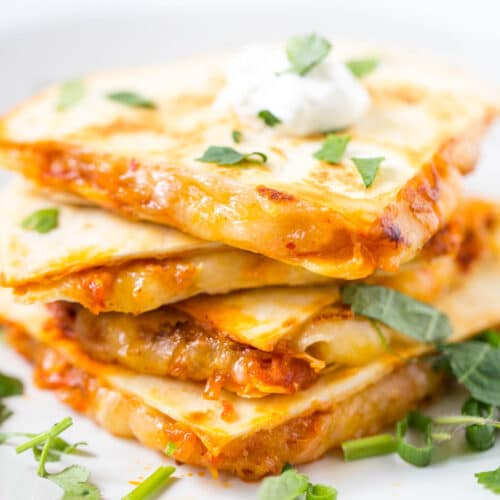
















I want to grow the green onions and cucumbers.
This year I’m growing the baekdadgi cucumbers shown in your article (same brand/packaging). They’ve outperformed my other cucumbers by a wide margin.
From what I’ve read, they’re an excellent multi-purpose cucumber, good for both salads and pickling.
My question is whether they’re an heirloom variety. Will I be able to harvest and use the seeds? From what I’ve read, most baekdadgi cucumbers are heirlooms, but I’m trying to pin that down.
Thanks! Love your website!
Hi John, sorry for the late reply. Yes, Baekdadagi Oi is an excellent multi purpose cucumber. But I’m sorry but I’m not completely sure if you can grow from the seeds or not. My guess is that if you grew it from a commercial seed packet, it’s probably going to be hard to grow from seeds next year but I may be wrong. Thank you for asking!
Hi – All the lovely varieties of Korean Veggies and great instructions! Could you please include a link to the seeds shop of yours so we can click and get there to buy buy buy.
Thank you for all your endeavor to educate us about Korean cultural events and your own journeys. I enjoy reading and cooking Korean food from your recipes. The soups and the meat dishes are absolutely my favorites.
This is a timely article because I’d just bought 3 packs of seeds at my local Korean market but I don’t read Korean so the instructions on the packages aren’t very helpful to me. In fact, I bought the exact goju seeds shown in this article.
But I also bought milk vetch and burdock, both of which I’ve never grown before. Any advice on those, or the best place to get advice for growing them?
I’m glad it’s helpful. As for milk vetch and burdock, I don’t have any ready to go instructions for that but I think you can just do a search online on growing instructions. FYI, I sell many Korean veg seeds in my Kimchimari shop and if you do, I send instructions for all of them via email. Good luck!